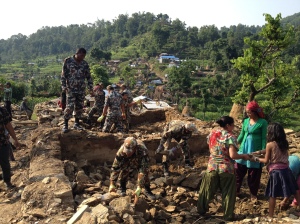The current Universal standards of human rights would have been inconceivable during the 20th century. Human rights have evolved over the years out of customs, traditions, precedents, mores and folks all over the world.
‘Rights’ in general are manifestation of years of accumulated experiences. In the sense, it has not come into existence all of a sudden. This is why different regions of the world value different kinds of rights. It is the same for Nepal as well.
Human rights in Nepal have been majorly derived from the theocratic establishment. This usually led to an appointment of a King who supposedly was believed to be the reincarnation of Lord Vishnu himself. Hinduism has been the major source for establishment of all kinds of rights in this entire region. The stratification brought about by the ‘caste system’ had a critical role in determining how people were supposed to behave with each other. This division was created on the basis of various occupations.
Ancient literature of ‘Shruti’ and ‘Smriti’ has influenced the common tradition. Distinction based on caste, sex, and ethnicity has been customary. In this way, human rights have had double standards in the Nepalese context.
Different dynasties brought a whole lot of variations in the governing law. Belief in certain texts and ideas has had an important role in the determination of peoples’ actions.
The Kirat era-
People followed each and every line of the ‘Mundhum’ diligently. Polygamy was sanctioned for men and inter-caste marriages were also allowed. Punishments were also derived from it. Kirati women had more freedom than Hindu women. Disputes were settled in the people’s court. Even the King was governed by the supreme law.
The Licchavi era-
They believed in the ‘Dharma Shastras’, ‘Mahabharata’ and the ‘Puran’. The Sati system was widespread but not compulsory. There was a very elaborate system of punishment based on the ‘Manusmriti’. Slavery was a natural thing.
The Malla era-
‘Dharmashastras’ were the main source for deriving general norms. As the king was considered the protector of religion, he was considered as ‘Dharma-Raj’. Jaya Sthithi Malla is considered as the main architect of law and justice system of this era. The Kings’ main duty was to make sure that all the castes worked in accordance of their entitlement. Stratification was also brought inside the Newar caste. If a woman married a man of a lower cast, she would automatically inhibit the low caste of the man.
The Shah era-
No significant reforms were taken for lower castes, women, backward classes. Bhramins, Jogis, women would not be sentenced to death. P.M Janga Bahadur Rana was inspired by the law system of France and England and also from Napoleon. He did nothing to reform the caste system and its rules. During this period the Rana family had the real power. King Tribhuwan Sati abolished the Sati system in 1977BS and the slave system in 1981BS.
For the first time Human Rights were included in the constitution of 2004 BS in which individual freedom, freedom of press, freedom of association and religious freedom were included. It was also recognized that with enjoying various rights citizens were also responsible to perform certain duties.
From 2007-2047 B.S
Within these four decades a lot of changes took place in development of rights and freedom, though with certain restrictions. But these rights were reserved only for certain sections of people. Certain rights were granted by the temporary constitution such as right to property, rights to establish business, right to travel, right to settle down anywhere across the country. It also forbade one from taking away someone else’s’ life and rights. Provisions were made for establishment of a Supreme Court. In 2012 B.S. the word ‘Citizenship’ was first introduced in the country. There citizens were entitled ‘right to life’. In 2015 B.S. a constitution was introduced with bore influences from western constitutions.
King Mahendra has been credited for introducing laws that were made applicable for everyone and not just the privileged class. Especially this broke the rigid caste system, which implied everyone is same in the eyes of the law. As customarily rulers were allowed to punish offender mercilessly by themselves, now this was prohibited. Punishment had to be sanctioned by law.
King Birendra allowed a referendum to take place in 2036 B.S. which gave the people the right to choose if they wanted reforms in the Panchayat system or wanted to opt for multi-party system. This referendum is considered as an epitome of freedom given to the people.
Currently Nepal is in a critical transition phase. The citizens of this isolated mountainous nation are becoming aware of the implications of living in a fully functional democratic nation. Though the constitution has not yet materialized we have already embarked on a venture that has sowed progressive elements for more rights and freedoms for every Nepali citizen.
.jpg)



No comments:
Post a Comment